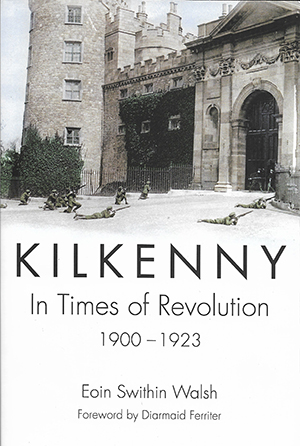KILKENNY IN TIMES OF REVOLUTION 1900–1923
Published in Book Reviews, Book Reviews, Issue 4 (July/August 2019), Reviews, Volume 27EOIN SWITHIN WALSH
Merrion Press
€19.95
ISBN 9781785371974
Reviewed by Pádraig Óg Ó Ruairc
 Pádraig Óg Ó Ruairc has a Ph.D in history and has written several books about the Irish Revolution.
Pádraig Óg Ó Ruairc has a Ph.D in history and has written several books about the Irish Revolution.
When most of us think about the Irish Revolution of 1913–23 a very limited geography and chronology of events tend to spring to mind. We think of the 1913 Lockout and the Easter Rising in Dublin, followed by the IRA’s guerrilla campaign in the counties where it was most intensely fought—Cork, Limerick and Tipperary. Likewise, the stereotypical narrative of the Civil War also tends to focus on events in the capital and in Munster. Events in Ulster during the period are rarely given the attention they deserve and the counties of Leinster are almost completely ignored.
To date, the best thing about the much-hyped ‘decade of centenaries’ has been the avalanche of new publications. By 2016 the bookshelves were already heaving with books exploring every conceivable aspect of the Easter Rising, and already so much has been published about the War of Independence in Munster that it seems unlikely that anything new remains to be written about the conflict there. This is what makes the publication of Eoin Walsh’s book on County Kilkenny during the Irish Revolution such a refreshing and welcome addition to the literature on the period.
Previously, both scholars and non-academic lovers of history had to rely on books such as J.J. Comerford’s My Kilkenny IRA days and Jim Maher’s In the shadow of Slievenamon—the Flying Column, west Kilkenny, which, whilst both of great value, only partially detailed events in the county. Walsh’s new book, based on his MA thesis, is the first comprehensive history of the county’s role in the national struggle for Irish freedom.
Although the body count in Kilkenny during the period was very low compared to other counties, Walsh nonetheless provides an engaging in-depth account of life in Kilkenny during the period and how the war affected civilians as well as combatants. The book contains sections examining how social movements and cultural groups locally, including the Gaelic League, the GAA, trade unions, local news media, the unionist aristocracy and religious leaders, influenced—and were influenced by—the political turbulence of the era.
The more interesting aspects of Walsh’s research are the fascinating personal stories he has unearthed: William Kenny, the ex-British soldier who spied for the British Army and was ‘disappeared’ by the IRA; Lord Ossory, the aristocrat who refused to vacate his home in Kilkenny Castle even after the IRA commandeered it as a barracks; Colonel John Prout, the Irish-American gunslinger who led the Free State forces in Kilkenny during the Civil War, accompanied at all times by his twelve-year-old son John Jr, whom Prout thought fit to arm with a revolver given the circumstances; and Thomas Davis, the informer from Thomastown who had worked for the RIC Auxiliary Division before being discovered by the IRA and forced into exile in England. Davis returned to Ireland during the Civil War, enlisted in the Free State Army, died during his military service and only narrowly missed being buried with full military honours when his comrades discovered his past as an informer just hours before the funeral was scheduled.
Another of the strengths of Walsh’s research is his analysis of intelligence matters during the War of Independence. He gives careful and sober analysis of both the executions of alleged civilian spies killed by the IRA and the tactics employed by the British forces, including the use of stool-pigeons incarcerated with IRA prisoners, to gather information, and the recruitment of local women as both informers and ‘female searchers’ with the RIC. The author gives detailed accounts of all of the major political and military developments in the county and has also included several lists giving a detailed breakdown of all the fatalities that occurred in Kilkenny during the War of Independence, truce and Civil War. The book is well illustrated with maps detailing the location of each fatality and contains over 30 period photographs, many of them never before published.
The only criticism that I would offer of the book is that the author did not make use of the interviews with veterans of the War of Independence and Civil War contained in Ernie O’Malley’s military notebooks in UCD Archives. These interviews often contain eyewitness accounts and important details of events that are not to be found in the Bureau of Military History and other better-known collections. Nevertheless, given the author’s extensive use of material from a variety of other collections in both British and Irish archives, this omission does not detract from the overall high standard of the book, which is comprehensive and detailed yet written in a clear and easily accessible style.
















